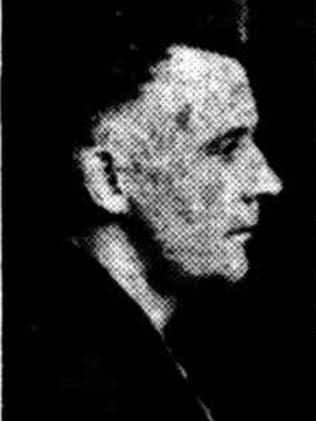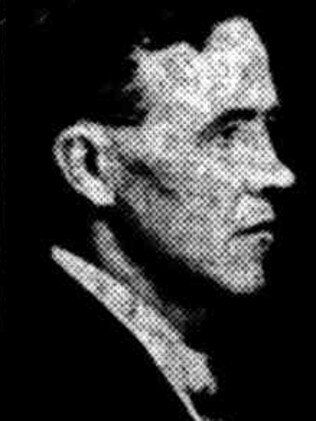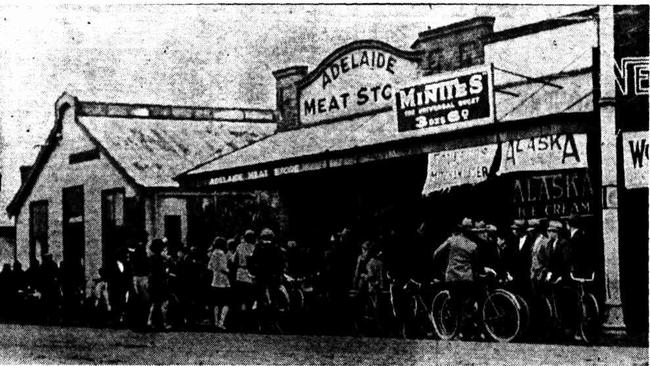True Crime Australia: The battle of Enfield ended in two out of four jail escapees killed
THE battle of Enfield saw bullets flying, two out of the four jail escapees killed, and the 38 police officers awarded for bravery. Andrew Dowdell recounts the July 1930 firefight, which was unlike anything Adelaide has seen before or since.
Our Criminal History
Don't miss out on the headlines from Our Criminal History. Followed categories will be added to My News.
DESPERATE men will risk everything for freedom, and on a gloomy winter morning during the Great Depression, four Yatala Prison inmates were playing for keeps.
William Henry Hayes, Arthur Harold Harrison, John Eustace Newchurch and Joseph Dawson had planned their escape with outside help — but only two of them would live to see the end of Friday, July 18, 1930.
The Battle Of Enfield was unlike anything Adelaide had seen before, and unmatched since, but these days few have heard the tale.
Over five hours of insanity, the men used smuggled shotguns to overpower and take a guard as a hostage and shield; forced him to jump from the speeding getaway car; tried to visit a Member of Parliament; and fired guns at police.
They jacked a truck as the panicked driver heroically held his wheel before a bullet ricocheted and hit him; they almost shot primary school children; before two were fatally felled when police bullets rained upon them in a manic final chase along Main North Rd.
When the battle finally ended and the sun set, the bullet-riddled bodies of Newchurch and Harrison lay in the city morgue, while Dawson nursed a minor bullet wound after surrendering to police at the height of the gunfight.
Hayes fared better, making a brief escape on a pushbike and spending several hours at large until he was also nabbed — the 31-year old decked out in a women’s dress, makeup and a hat and high heels.
A lorry driver copped lacerations to the head and shin after being accosted and ordered from the wheel by the desperate criminals, while a Nailsworth father received a pellet wound to his heel while trying to stop them stealing his vehicle.
Two of the more than 30 police officers involved sustained shotgun pellet wounds to their lip and arms, but were not seriously hurt.
Bravery awards were later handed to 38 police officers, including one Constable who would half a century later remember the shootout as “fun and exciting”.
Few, if any, would still recall the Battle Of Enfield, but it stands as a reminder of the risks people will take when they have nothing left to lose.


THE ESCAPE
Yatala Labour Prison is today South Australia’s highest security prison — home to the most violent and dangerous criminals and killers that has been modernised since a major redevelopment in the 1980s.
But in the grim winter of 1930, Yatala was already an archaic home of punishment and discomfort, with a daunting and aged facade, akin to the Old Adelaide Gaol.
As the tsunami-like waves from the 1929 Stock Market crash pounded Australia, even middle-class working families survived on food vouchers and life inside Yatala neared unbearable.
At 8am sharp on that fateful Friday, two guards named Berg and Strawson went with a work group of 29 inmates to a rarely-used quarry on the outskirts of Yatala, about 15km northeast of the CBD and at that time outside suburbia.
Among the group were Hayes, Dawson, Newchurch and Harrison.
And they had no intention of working that day.
The quartet, with help from a never-identified outside source, retrieved shotguns left hidden for them and startled guards August Berg and Edwin Strawson.
Strawson became a temporary hostage, who they ordered towards a blue Whippet getaway car, also left for them nearby.
At the wheel was Dawson, who was only months into an eight-year sentence for robbery under arms, with the three other convicts wielding shotguns and a rifle.
Clutching to the footboard on the side of the car, as he had been ordered to, was the guard Strawson.
Nervous and exhilarated, Hayes yelled “let’s blow his f … ing brains out” as he cocked the shotgun at Strawson, and remarked “let’s finish him off, we have nothing to lose and everything to gain”.
But rabbit trapper Harrison threw himself across the older man’s loaded weapon, shouting “no, no, none of that”, likely saving the guard’s life in what proved to be his own final hours.
Hurtling along what’s now Grand Junction Rd and away from servitude, the men decided they were in the clear and Strawson had served his purpose, and he was forced to jump at speed on to the road — bruised, sore and shaken but alive.
Aboriginal man Newchurch had previously escaped jail and was restrained with leg irons, which he spent about an hour hacking through before being able to move freely.
The four continued east towards Tea Tree Gully and the Adelaide Hills, where they had someone to see.


SUMMERTOWN BLUES
The blue car with four occupants lurking outside the post office immediately raised eyebrows in the hills town of Summertown around 10.25am.
One of the men approached a young female assistant at a nearby shop, asking where they could find the home of the local Member of Parliament at the time.
He claimed to be “just over from New South Wales” and asked to be pointed towards the home, before the sound of approaching voices startled him and the car sped off.
A Mounted Constable arrived at Summertown shortly after, and urged his horse towards the MP’s home, checking the road for evidence such as tracks, however the thick fog that enveloped the hills as lunch time approached hampered his search and the men were gone again.
For reasons never properly explained, the criminals-at-large then drove back into Adelaide, where their first truly bad stroke of luck came in the form of Constable Bill Dohoney.
Aware of the escape and driving a private car, Constable Dohoney immediately recognised Newchurch and within minutes he retrieved two colleagues and tailed the quartet along Stephen Tce through St Peters into Walkerville.
After crossing the River Torrens, the police drew closer and outside the Sussex Hotel, they called out of the car asking the men to stop.
No words were needed to clarify the response, as one of the escapees blasted the shotgun at the trailing vehicle.
As bullets hurtled back and forth, a shot by one of the police shattered the back window of the sedan, stolen from Unley the previous day, which continued to race north at what were described in reports as “breakneck speed”.
More police scrambled to the vicinity on roaring motorcycles with sidecars and in teams in cars, while both the convicts and Constable Dohoney’s cars had their rear tyres punctured in the relentless mobile gunfight.
The police vehicle gave out first, but they were in luck as they sprinted along Main North Rd, quickly realising their targets had suffered the same mechanical malaise and were also now on foot.

RUN THROUGH THE SUBURBS
When their blue sedan’s tyres shredded completely, Dawson lost control of the vehicle and it swerved into the front fence of a home two doors along from the Nailsworth Primary School.
Now without a car, the men sprinted through backyards of homes and into the school grounds, around the time that a car with two detectives and a motor traffic constable arrived.
The school was quieter than normal on a Friday, because most of the pupils were watching a footy game at nearby Prospect Oval.
By this time, Constable Dohoney’s pursuit team had caught up and he called out for Newchurch to put down his powerful .303 rifle.
Newchurch cried out: “Stand back you (expletive) or I will blow your balls inside out” before running into the school.
Constable Dohoney was out of ammunition and forced to retreat, leaving Detective-Sergeant McMahon and Constable William Delderfield in the firing line near the school.
School staff said a shot fired by one of the fleeing men tore through a flimsy asbestos wall into a classroom, missing two students by less than a metre.
Sgt McMahon spotted the men standing on the lawn behind the home of the Gill family on Thomas St at Nailsworth and again urged them to surrender.
Newchurch raised and fired his rifle at Sgt McMahon and Const. Delderfield, just before Hayes and Dawson fired sawnoff shotgun blasts, some of the projectiles hammering into a brick wall just behind the officers.
It was around this time Hayes made the smartest move of his day, jumping about 10 fences then stealing a bike which he stealthily rode away from the cacophony of gunfire towards the city.
After failing in their attempt to steal the Gill family’s vehicle, Harrison, Dawson and Newchurch took refuge inside a home, followed by two policemen.
Dawson was hit but not grievously injured during the indoor gunbattle, losing his appetite for battle and surrendering without further violence.
“I give in. I know when I’m beat,” Dawson said in resignation.

THE FINAL STAND
Newchurch and Harrison, both 27, chose not to surrender and bolted from the home back towards Main North Rd, about the time a lorry driven by Prospect Council worker William Menadue rumbled into view.
Mr Menadue’s workmate Thomas James was forced to jump from the moving sand-laden truck as Harrison levelled his weapon at their faces.
“Drive like Hell, drive like Hell or we’ll blow your f … ing head off,” Harrison screamed.
Newchurch jumped on to the back of the truck and continued firing at the cavalry of police, which by now numbered more than 20.
Despite bravely struggling for control of the wheel with Harrison, Mr Menadue also had to abandon his truck in fear of being hit by one of the barrage of police bullets peppering the truck.
The 42-year-old was struck by a bullet or shrapnel, escaping the ordeal with head and shin lacerations but not serious injuries.
The Coroner would later congratulate Mr Menadue for his bravery in keeping his nerve as Harrison’s muzzle wavered in his face.
Along this final path to destruction, the convicts fired shots through the plate glass window frontage of a popular butcher’s shop, sending women and staff into survival mode as they fell on to the sawdust-covered floor in shock.
But the numbers game was up for Harrison and Newchurch, who was fatally shot and slumped on to the load of sand.
Harrison, who earlier had been the voice of reason over Hayes, was by now out of his mind in panic and refused to stop the lorry.
It was the last decision he would make and of the five bullets which hit him, a shot through his torso penetrated his heart and lungs, killing him almost instantly.

WHERE’S HAYES?
Hayes had managed to skip the net as the sound of gunfire echoed across the northeast of the city, finding refuge at a friend’s home on Chatham St in the city.
But his liberty was fleeting, and his capture later that night came without the violence that left two of his friends dead.
Wearing face makeup and powder and dressed in a print dress with stockings and white heels, the armed robber and fugitive hid his short hair under what a newspaper referred to as a “smart little black hat”.
In a bemusing scene, the chastened Hayes asked the detectives if they would be kind enough to carry him across the street because rain had made it too slippery for him to walk in the women’s shoes.
Hayes’ friend Charles Groetsch was charged and convicted with harbouring the fugitive, who was forced to appear in court the next morning still adorned in heavy makeup.
The court heard that when Hayes was arrested, he told police he planned the escape because “I wanted to give the place a little publicity”.
“I wanted to show the public the dreadful manner in which prisoners are being treated. If this is the means of bringing about a public inquiry I will go back a pleased man,” he said.
Hayes and a still-limping Dawson were jailed for 15 years with hard labour for their trouble, and Hayes was found guilty of shooting at — but not attempting to murder — two of the policemen at Nailsworth.
Dawson said nothing of note during their court hearings, but Hayes was keen to elaborate on his motivations and to insist he never wanted to kill or hurt Guard Strawson or police.
Hayes admitted he fired in the direction of the police but deliberately missed, and said he only threatened to shoot the prison guard to scare him and keep him quiet.
Telling the court he had a clean record until four years prior, Hayes handed the judge a bundle of papers which he said contained complaints and grievances about their deplorable treatment inside Yatala.
Despite his resulting notoriety, Hayes went on to prove he had both a soft side and a prodigious talent for art.
In 1932, he used a penknife to handcraft an elaborate dolls’ house from inside his cell, a four-room furnished model home which the newspaper article described as “a marvel of ingenuity”.
Hayes donated the doll’s house to the Adelaide Children’s Hospital, which he also gifted with a miniature merry-go-round a year earlier.
“I love children, but have none of my own,” the high-security prisoner wrote to hospital chiefs.
“I desire no recompense for any article I may send unless I could, perhaps, receive a photo of the children playing with the toy.
“Hoping some kind person will buy dolls to occupy the house and with deepest sympathy to the poor sick children.”

MAD AS CUT SNAKES
In 1986, former Constable Bill Dohoney spoke about the Battle of Enfield in The News.
Far from traumatised by the events of July 1930, Mr Dohoney described the chase and shootout as “the most exciting day of my 25-year career in the police force”.
“I can remember it as if it was yesterday. We did not hesitate to chase them even though we knew they were armed,” the then 85-year old said.
Mr Dohoney said he was “young and fearless” and added: “We were mad as cut snakes in those days.”
“It was fun because nothing like that happened in Adelaide in those days,” he said.
He joked that the gunfight had hastened his marriage to his wife Mavis, who was a “little upset” and “said she wanted to get married before I was killed”.
Mr Dohoney was among survivors to watch a 1986 dramatic recreation of the saga, which cost two young men their lives and did little to improve the lot of inmates held inside the cold stone walls of Yatala Labour Prison.
Originally published as True Crime Australia: The battle of Enfield ended in two out of four jail escapees killed
